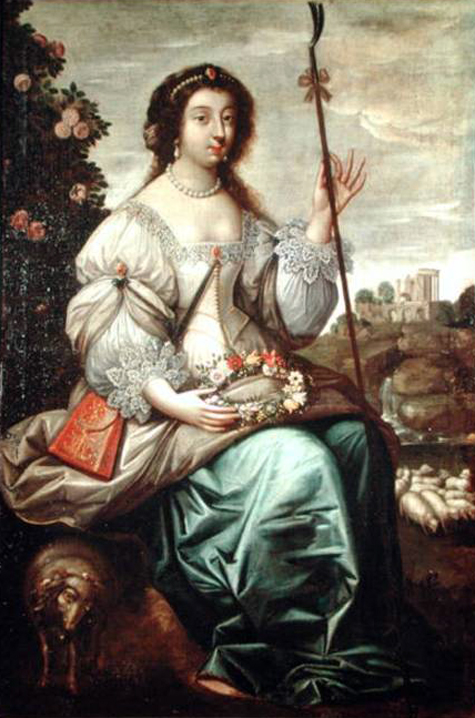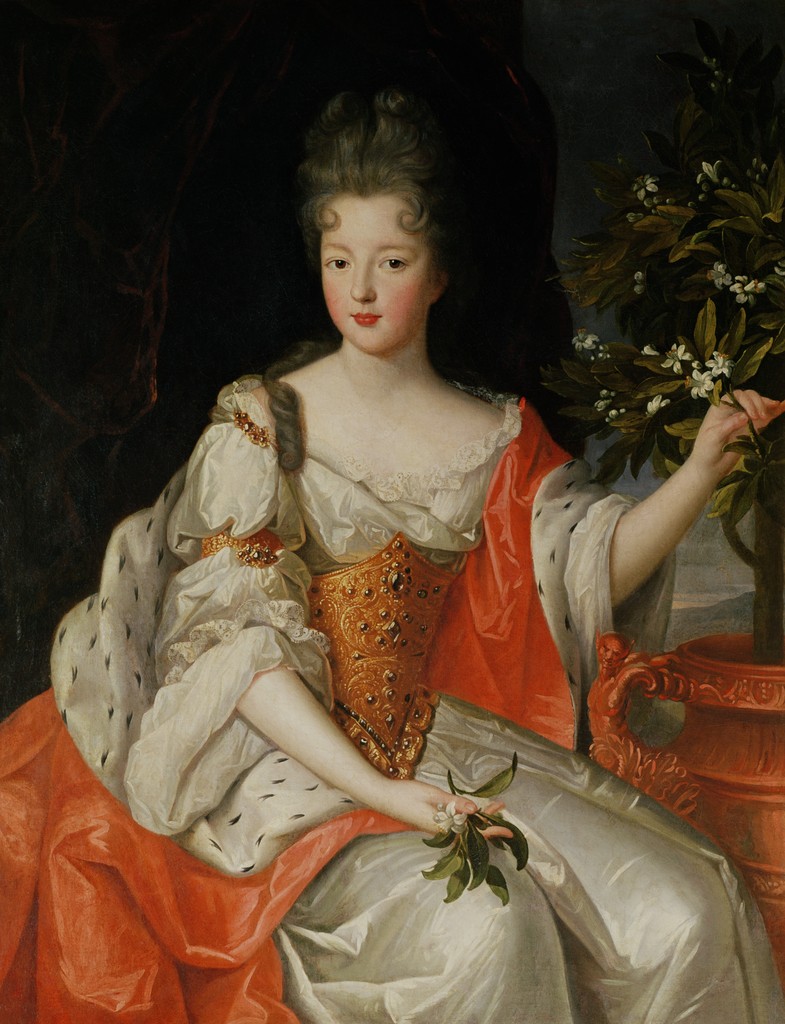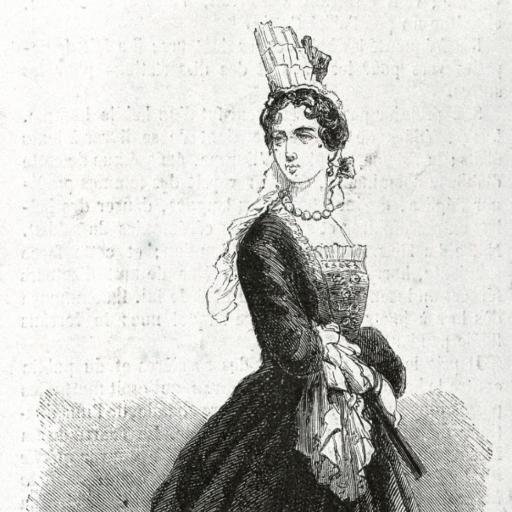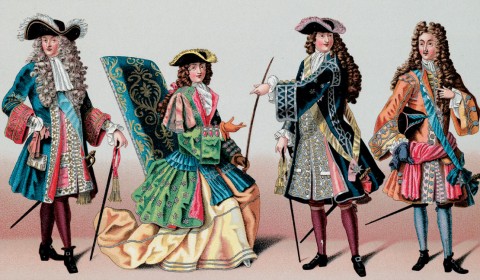Julie d’Angennes, Duchesse de Montausier
Julie-Luciana d’Angennes was born in 1607 in Paris as daughter of Charles d’Angennes and the famous Catherine de Vivonne. Charles and Catherine married as she was twelve years old and they had seven children, two boys and five girls.

Catherine, known as Madame de Rambouillet, was a very famous lady. She hosted the first and most brilliant Parisian literary salon, nicknamed chambre bleue, in the Hôtel de Rambouillet and all the important and smart people flocked to it. Little Julie was a major asset of this salon. The guests called her Princesse Julie and showered her with compliments. She served as muse for poets and writers. Her beauty and wit was praised by everyone.
Julie was also very caring and kind. As her little brother, the Vidame de Le Mans, fell ill with the plaque she distinguished herself by nursing him to the end, which made her gain even more adoration from everyone.
Among the great men showering her with attention, was
Charles de Sainte-Maure, Baron de Montausier. A gentleman who had earned glory on the battlefield while fighting in service of a great German Prince. He saw Julie for the first time in 1631, the year her younger brother died, and apparently fell in love with her at once…. but that is said to have happened to a lot of men. While Julie charmed in her mother’s salon, Charles went off to war again. He returned to the French service in 1636 and fought many battles in the following years… and also one for Julie’s heart.
Mademoiselle de Rambouillet, or l’incomparable Julie as many called her, was very aware of Charles’ feelings. Pretty much everyone knew he was after her… but Julie was a bit undecided… and this did not change for the next ten long years. The Baron de Montausier wooed and wooed and wooed and wooed with admirable stamina, but no success. So, he decided to make her the gifts of gifts for her name-day.
Being himself a frequent guest at the Hôtel de Rambouillet, he asked the others to write madrigaux, a sort of short poem, in which a flower would sing praise of Julie. Nineteen poets agreed to help him out, among them celebrated writers like Georges de Scudéry, and Charles wrote sixteen of the sixty-one poems himself. He brought the collected texts to the calligraphist Nicolas Jarry and miniaturist and engraver Nicolas Robert, who later became court painter to Louis XIV, adorn the manuscript with flowers, each illustrating a quality of Julie. It turned out to be a true masterpiece of art and literature and received the name la Guirlande de Julie.
Julie found the work on her bed as she woke up on her name-day, May 22, in 1641 and was very touched by it…. but it was still not enough to give in to Charles’ wooing. He went to war again and another four years passed until Julie finally said oui. In the meanwhile, after the French lost the Battle of Tuttlingen in 1643, Charles was taken as war-prisoner and spent ten months as such, until his ransom could be paid.

As Charles finally returned to France, he was promoted to lieutenant-general, made a Marquis and heard that oui he waited fourteen long hears for. Julie agreed to marry him. For that, Charles, being educated as Protestant, quickly converted and became a Roman Catholic. Julie and Charles married on 13 July in 1645.
Julie gave birth to a daughter, called Marie-Julie, on 21 July 1646, pretty much a year after they married.
Then the Fronde happened. France was at war with France, nobles rebelled and members of the royal family fought each other. Charles had some problems with Cardinal Mazarin, but stood firm at the side of the young King. The Marquis was badly wounded and because he fought bravely for the Kingdom, showered with more glory and esteem once the whole thing was over. Some could not quite understand that, because Charles was apparently quite strict, a bit grumpy and had not the best manners. It was even rumoured he might be the inspiration for the character of Alceste in Molière’s Le Misanthrope ou l’Atrabilaire amoureux. (Alceste is extremely unpopular due to rejecting fun things and salon-culture. He does not want to play along and moans about this and that all the time, which makes people avoid him. He is quick to complain and criticise others, also himself, and is of the opinion the world is shallow and only cares about silly things. Despite that, he is utterly in love with Célimène, who embodies pretty much everything he complains about.)
Their daughter, Marie-Julie, made quite the impression as well. She was introduced to Louis XIV and Anne d’Autriche in August of 1659 and Anne was at once enchanted. So much, that she invited Charles to be more present at court and take part in the upcoming wedding of the King. As Marie-Julie was officially introduced at court the following year, she became one of its brightest shining jewels.
The high esteem in which the King held Charles, also reflected on Julie. As Marie-Thérèse d’Autriche became pregnant and the time for the birth approached, preparations for the future household of the child had to be made. The child needed nurses and wet-nurses, maids and valets, and most importantly the child needed a governess. Someone kind and caring, pious and yet charming, someone trustworthy and devoted. Julie was appointed gouvernante des enfants de France, which meant all future royal children as well, in September 1661 and held the position until 1664, when she was appointed première dame d’honneur to the Queen. As such she was responsible for the Queen’s ladies-in-waiting… not an easy task. Not so much because of the ladies, more because of the King chasing after the ladies. Julie’s predecessor, Susanne de Navailles, was dismissed and exiled, because she made it hard for the King to chase after said ladies… among them Louise de La Vallière.
In the meanwhile, Charles climbed higher on the favour-ladder and was welcomed by Louis XIV into the order of the Saint-Esprit. He also received the government of Normandy and in 1664, he was made Duc and Peer. The same year, their daughter Marie-Julie married Emmanuel de Crussol, who later became the Duc d’Uzès. (One of their daughters, Julie-Françoise, married Louis-Antoine de Pardaillan de Gondrin, the only son of Monsieur and Madame de Montespan.)

Julie’s new office turned out to be quite the task for her and had a serious effect on her good reputation. The Duchesse de Montausier often said she was strictly against adultery, but Louis XIV did not care much for that. He started to grow tired of Louise de La Vallière and began to ogle one of Louise’s friends, the haughty Madame de Montespan. Both, Louise and Athénaïs, were ladies to the Queen.
Athénaïs was a quite likeable person and became friends with Julie. They often shared rooms when travelling with the unhappy Queen. The latter urged her husband to stay away from Louise, who was pregnant, not knowing that Athénaïs had become the object of interest in the meanwhile. Julie might have known that already back then…
She certainly knew what was going on as both shared quarters again during the War of Devolution. Louis XIV could not longer resist Madame de Montespan and took to paying her secret visits, sometimes dresses up as a Swiss Guard. To make that easier for him, Athénaïs spent plenty of time in her room, saying the summer heat gave her a headache. Of course, some people noticed all of that… an unsigned letter was written to the Queen, saying the King was no longer in love with Mademoiselle de La Vallière and now courting Madame de Montespan, with the Duchesse de Montausier covering for them and arranging secret meetings between them with the help of her husband.
Marie-Thérèse did not believe a word of it and argued it was impossible that two ladies, who are as loyal to her as Julie and Athénaïs are, could betray her in such a horrible way. Julie denied having anything to do with any of the King’s affairs…
…but she must have known what was going on. Madame de Montespan became pregnant, the child was hidden away, Monsieur de Montespan, who was of the jealous sort, flew from one rage into the next. As Julie’s husband was appointed governor of the Dauphin, he told everyone it is Julie’s doing and a reward for the Duc and Duchesse helping the King to sleep with his wife. Julie also witnessed his rages first hand. Athénaïs, fearing her husband might attack her in her sleep, sought refuge in Julie’s rooms in order to have some peace of mind… but Monsieur de Montespan found her there and attempted to force himself upon her, with Julie present.
All of that left an effect on Julie. She was constantly nervous and thus decided to retire permanently from court to one of their country estates in 1669. She gave up her position as première dame d’honneur as well, but was not replaced as such until 1671, by Anne Poussard de Fors du Vigean, Duchesse de Richelieu. Julie died the same year, on 15 November 1671.





